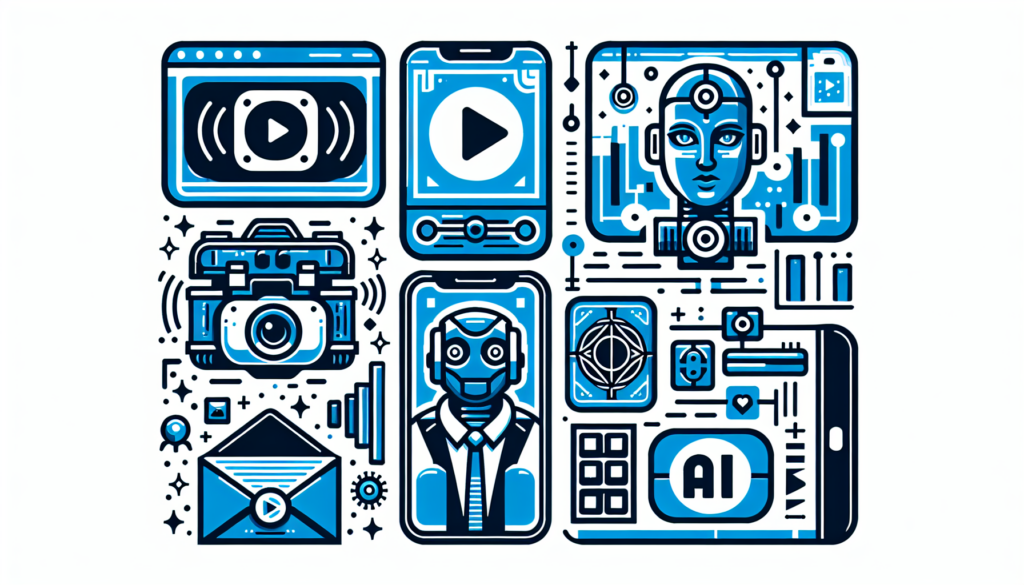Imagine a world where you’re not just harnessing the power of Instagram Reels but also using Artificial Intelligence to cater to your audience’s every preference, curating content that grabs attention and drives engagement. Welcome to the future of social media marketing, where AI meets Instagram Reels. Dive in to unlock the secrets of this game-changing combination. Using AI for Instagram Reels allows for optimized content creation, personalization, and trend prediction, potentially increasing engagement and followers, thus boosting one’s social media presence and creating opportunities to monetize their account.
Getting Started with AI for Instagram Reels
Harnessing the power of Artificial Intelligence for Instagram Reels may not be as intimidating as it sounds. Get ready to reimagine your content strategy as we familiarize you with transforming reels, setting them up for enhanced viewership, and personalizing them to narrate your unique story.
Understanding the Reels You Want to Transform
Understanding the exact nature of the Instagram Reels you want to transform is the primary step in leveraging Artificial Intelligence (AI) for your benefit. Every reel possesses distinct characteristics and peculiarities, from length and resolution to content type and audience engagement patterns.
For instance, a reel with a higher engagement rate may reflect the specific preferences of your audience, which can guide your AI tool in automatically enhancing certain aspects of your content. Additionally, real-world evidence supports this understanding-based approach, with Instagram and Social Media experts like Andrew Hutchinson highlighting that understanding the intricacies of Reels can significantly streamline your AI transition journey.
This understanding will help in analyzing existing data more accurately, predicting trends, and customizing content, all of which lead to enhanced audience visibility and engagement. Hence, leveraging AI for Instagram reels requires a transition that smoothly integrates your understanding of the reels with the AI tool’s capabilities.
- Understand the specific characteristics of the Instagram Reels you want to transform, such as length, resolution, content type, and audience engagement patterns.
- Analyze engagement rates and audience preferences to guide your AI tool in enhancing certain aspects of your content.
- Integrate your understanding of the reels into the AI tool’s capabilities to accurately analyze existing data, predict trends, customize content, and enhance audience visibility and engagement.
Setting Up Your Instagram Reels on Article
Setting up your Instagram Reels begins with an aligning understanding of the AI technology that powers it. Instagram’s Reels use advanced AI algorithms that learn from past interactions, feed posts, and searched content to curate and suggest new clips based on your preference.
It accomplishes this by analyzing both visual and textual elements within posts. For example, if you frequently share food content, the system will learn this preference and recommend similar content.
To start creating your Instagram Reels, select the Reels option at the bottom of the Instagram camera. From there, you can craft your content by adding music, AR effects, and editing tools such as timer and countdown, align, and speed, making the creation process easier and more enjoyable.
Mastering these elements will enable an effective and engaging presence on Instagram Reels.
- Understand Instagram’s Reels AI technology, which learns from your past interactions, feed posts, and searched content to suggest new clips based on your preference.
- Get familiar with creating Instagram Reels by selecting the Reels option at the bottom of the Instagram camera and using music, AR effects, and editing tools such as timer and countdown, align, and speed.
- Master the elements involved in creating Instagram Reels to establish an effective and engaging presence.
Customizing your Reels into an Article
Customizing Instagram Reels into an article involves a creative process that requires a clear understanding of your audience and the story you want to tell. AI tools, such as the Generative Pre-trained Transformer 3 (GPT-3), can help streamline this process by creating text-based content from video scripts, saving time and effort.
For example, AI can extract keywords from your Reels’ audio and generate a draft article based on these keywords and the visual context. This technology can also suggest hashtags and other SEO-friendly phrases to increase your article’s reach.
Thus, combining the power of AI with Instagram reels can result in engaging, keyword-rich articles that garner increased online visibility. This maximizes the use potential of your visual content and ensures a smoother content-creation process.
- Understand your audience and the story you want to tell when converting Instagram Reels into an article.
- Use AI tools like GPT-3 to create text-based content from video scripts, saving time and effort.
- Combine AI with Instagram reels to create engaging, keyword-rich articles that increase online visibility and streamline content creation.
Adding Customizations to Your Content
Amplifying your content’s impact goes beyond just crafting an engaging narrative. By exploring choice media, integrating personalized features, and tailoring your output methods, you can transform your now standard material into a compelling, unique experience for your audience.
Selecting Your Media
Choosing your media format is an integral part of customizing your content.
Indeed, selecting the correct type of media – be it text, images, audio, or video – can significantly impact how your message is received and perceived and can either boost or hamper your engagement rates.
Visually engaging forms of media, such as infographics, have been found to increase web traffic by up to 12% (Chock, 2017). Similarly, video content is shared 1,200% more times than links and text combined (Zephoria, 2019). Hence, weighing the nature of your content and target audience is crucial when settling on a media form.
Nevertheless, embrace diversity; mixing various media formats can cater to different learning styles, avert monotony, and enhance the overall user experience.
- Decide on the appropriate media format for your content – consider text, images, audio, or video to convey your message best.
- Evaluate your content’s nature and target audience to choose the most influential media form.
- Embrace diverse media formats to cater to different learning styles, avert monotony, and enhance the user experience.
Adding Personalized Features
Incorporating personalized features into your content prompts a stronger connection between your brand and your audience.
For instance, using an individual’s name in an email subject line can significantly increase open rates, according to data by Campaign Monitor.
Additionally, interactive content such as quizzes or surveys not only tailors the experience to each user but also provides essential insights to further customize future content.
Moreover, features like personalized recommendations based on past behavior or preferences have been proven successful by companies such as Amazon, which stated that 35% of their sales are driven by their recommendation engine, according to a report by McKinsey.
To maximize the impact of these personalized elements, ensure a smooth integration into your overall content strategy, creating a cohesive, interactive, and highly engaging user experience.
Customizing Your Output Options
In the realm of content creation, customizing output options provides an opulent canvas on which to fine-tune and distinctively present your material.
For instance, let’s take blogging platforms like WordPress or Blogger; these platforms offer wide-ranging customization tools, such as the capacity to select distinct fonts, incorporate media, and adjust the layout to suit your unique demands.
Data from user engagement studies have consistently indicated that customized content boosts reader engagement, complemented by optimized readability and personalized visual appeal.
To ensure a seamless user experience, switch smoothly between customization options, enabling a steady creativity flow.
This transition can be as simple as switching the font for a different section or as dynamic as embedding an interactive infographic right in the heart of your content.
Generating Your Article
Diving into the dynamic article creation world can be exciting and challenging. This section will walk you through the intricacies of customizing your content, the simple click that brings your article to life, and the seamless process of exporting your piece to engage your readers.
Reviewing Your Customizations
“Before generating your finalized article, reviewing your customizations carefully is essential. Any changes to layout, format, text size, or color variants must be double-checked to ensure they meet the expected standard and correspond with your overall content strategy.
For instance, if you decide on a minimalistic design with a black-on-white text format, ensure all sections follow this pattern and don’t suddenly shift to colored backgrounds or different text sizes. Disparities can disrupt the visual flow and readability of the article.
Use keywords or short phrases from your customization parameters as a roadmap, ensuring you fully apply them throughout. In doing so, you maintain design consistency and enhance the readers’ engagement and comprehension.”
- Review all customizations, such as layout, format, text size, or color variants, to ensure they meet the standard and align with the content strategy.
- Maintain design consistency, ensuring that all article sections follow the chosen patterns, such as a minimalistic design with a black-on-white text format without disruptive color or size variations.
- Use keywords or short phrases from your customization parameters throughout your article to maintain design consistency and enhance readers’ engagement and comprehension.
Clicking the Generate Button
When you’re ready to generate your article, the “Generate Button” is your essential tool. Upon completing your content’s preparation, including selecting the topic, carving out sections, and more, clicking this button initiates the creation process.
For instance, after performing your keyword research and typing them in, pressing the generate button employs cutting-edge AI algorithms that scan the database for relevant content. The complex technology behind this process ensures a unique and contextually accurate article, framed according to your instructions and delivered remarkably faster than manual writing.
Note that the quality and accuracy of your generated article strongly depend on the details you’ve inputted, which underlines the importance of careful preparation before hitting the button. Incorporating this smart technology into your writing process fosters efficiency, time-saving, and an overall enhancement of your writing productivity.
- Complete the preparation of your content, including the selection of the topic and the carving out of sections, before using the “Generate Button.”
- Input keywords and then press the generate button to utilize AI algorithms and develop a unique and contextually accurate article faster than manual writing.
- Ensure the quality and accuracy of the generated article by carefully inputting the details during the preparation stage to enhance your writing productivity.
Exporting Your Article
Exporting your article is the final step in generating it. After you’ve put in the hard work of researching, writing, and revising, you’ll need to decide on the most effective way to get your work out into the world.
Depending on where and how you plan to publish the article, you may choose to export it as a plain text file, a Word document, a PDF, or even a rich text format. Double-check all formatting before finalizing your export, mainly if the article includes elements like images, citations, or a bibliography.
Remember to save your work one last time before exporting—there’s nothing worse than losing all your hard work due to a last-minute technology glitch. With sufficient attention to detail during the exporting process, you can ensure that your finished product looks professional and is ready to impress your readers.
Automating Your Article Creation
Unleashing the power of automation can revolutionize your content creation process. This section will guide you through effectively auto-embedding media, configuring automation for content generation, and integrating multi-platform solutions into your workflow.
Understanding Auto-Embed Media
Understanding Auto-Embed Media plays a pivotal role in automated article creation. Auto-embeds allow you to easily incorporate different media types, such as videos, images, or social media posts, directly into your content, enriching the reader’s engagement.
For instance, instead of just writing about a trending music video, you can use an auto-embed feature to include that video in your article directly. The WordPress platform, amongst others, has embedded capabilities for many sites, making the media inclusion process a breeze.
However, seamless transitions between your auto-embedded media and written text are crucial to consistently maintaining balance and coherence in your content. Appropriate captions, or transitional words and phrases, can prove instrumental in knitting together your media and text to create a seamless reading experience.
- Use auto-embeds to incorporate different types of media, such as videos, images, or social media posts, into your content to increase reader engagement.
- Use platforms like WordPress with embedded capabilities to simplify the media inclusion process in your articles.
- Keep your content coherent by ensuring seamless transitions between your auto-embedded media and written text with appropriate captions or transitional words and phrases.
Setting Up Automation for Content Generation
Initiating automation for content generation should be a fundamental part of your overall strategy for automating article creation.
Employing software like Artificial Intelligence (AI) can make the process more efficient by automatically generating blog post ideas, titles, outlines, and even whole articles based on specified keywords or topics.
One successful example of this is the Associated Press, which utilizes automation to produce a staggering 3,000 financial reports every quarter.
Integrating such tools isn’t just about maximizing volume and ensuring consistency and high-quality content.
Setting up good content-generation habits can significantly facilitate a smooth transition to the next step of your automation, like automating your editing process.
- Initiate automation for content generation as a core part of the overall strategy for automating article creation.
- Use software like AI to automate the generation of blog post ideas, titles, outlines, and even whole articles based on specified keywords or topics.
- Establishing good content generation habits will facilitate a smooth transition to the next stage of automation, like automating the editing process.
Incorporating Multi-Platform Solutions into Your Process
Incorporating multi-platform solutions into your article creation process can significantly streamline your productivity and ensure consistency across different platforms. One evidence of this is the increasing use of content management systems like WordPress, which allow writers to create and edit their content on one platform and then distribute it across multiple online locations simultaneously.
This not only saves time but also ensures uniformity in content presentation. For instance, if you are drafting a blog post, you can write, format, and optimize it on one platform and then smoothly publish it on your website, social media pages, and e-newsletter.
Consistent content portrayal not only makes your brand look professional but also enhances your audience’s experience. Therefore, transitioning to such multi-platform solutions is a practical and efficient way of automating your article creation process.
- Integrate multi-platform solutions into your article creation process for better productivity and consistent content across different platforms.
- Utilize content management systems such as WordPress to create, edit, and distribute your content across multiple online platforms simultaneously.
- Adopt multi-platform solutions to automate your article creation process, enhancing your brand’s professionalism and improving the audience’s experience.
Utilizing Multi-Platform Solutions
Multi-platform solutions aren’t just the future—they’re the now, rapidly transforming the way we create, distribute, and interact with content. This section will guide you through the process of comprehending such solutions, selecting the right platform tailored to your specific content needs, and leveraging these platforms to their maximum potential.
Understanding Multi-Platform Solutions
Understanding multi-platform solutions requires a grasp of both the potential benefits and complexities of working simultaneously with different systems and platforms.
It essentially involves the application of software or technology that works on several distinct platforms — such as web, mobile, or desktop applications — providing a multifaceted approach to reaching your target user base.
For instance, businesses find value in multi-platform solutions as they can reach a broader audience, with each platform tailored to specific user behaviors.
However, the challenge lies in ensuring consistency in quality and user experience across these differing platforms.
To avoid disjointed transitions, adjudicate a seamless user experience through careful design and strategic planning, adjusting the application to suit the specifics of each platform while maintaining its functional core.
Choosing the Correct Platform for Your Content
Choosing the correct platform for your content is paramount in multi-platform solutions. The platform you employ depends not only on the type of content you plan to produce but also on the preferences, behaviors, and demographics of your target audience.
For example, short, visually appealing content might perform well on Instagram, while long-form articles may be more suited to a platform like Medium or your own website. Additionally, data from the Pew Research Center reveals that age heavily influences social media platform preference, with younger users prefer Instagram and Snapchat while older users lean towards Facebook.
Hence, it’s imperative to understand your audience and choose your platform accordingly. Seamless user experience across all platforms is the end goal, necessitating the need for smooth, cross-platform compatibility and integration.
- Identify the type of content you plan to produce and understand the preferences, behaviors, and demographics of your target audience to choose the correct platform for your content.
- Use data from credible sources like the Pew Research Center to understand which social media platforms are favored by different age groups.
- Ensure smooth, cross-platform compatibility and integration to provide a seamless user experience across all platforms.
Maximizing the Use of Chosen Platforms
It is essential to fully understand each individual platform’s capabilities and nuances to capitalize on the use of selected platforms within multi-platform solutions.
For instance, one platform might excel at engaging younger users with graphics-intensive content, while another might offer better tools for data collection and analysis.
Companies such as Netflix have adeptly integrated multiple delivery platforms – from smart TVs and gaming consoles to mobile devices – seamlessly supporting user viewing habit shifts while maintaining a consistent brand experience.
Therefore, an in-depth knowledge of each platform’s strengths and weaknesses can help to create a more targeted and effective strategy.
Smooth transitions from one platform to another are pivotal and can be achieved through a meticulous understanding of user flow and the insight-driven implementation of interface design elements.
Frequently Asked Questions
What benefits does using AI for Instagram Reels bring?
Using AI for Instagram Reels allows for optimized content creation, personalization, and trend prediction, potentially increasing engagement and followers, thereby enhancing one’s social media presence and creating opportunities to monetize their account.
How can AI help transform Instagram Reels?
AI can help understand the exact nature of the Instagram Reels you want to transform. This includes understanding the reel’s characteristics, such as length, resolution, content type, and audience engagement patterns. This understanding helps in accurately analyzing existing data, predicting trends, customizing content, and enhancing audience visibility and engagement.
How to set up Instagram Reels?
To create Instagram Reels, select the Reels option at the bottom of the Instagram camera. From there, you can add music, AR effects, and editing tools like timer and countdown, align, and speed to craft your content. Mastering these tools can enable an effective and engaging presence on Instagram Reels.
How can we customize Instagram Reels into an article?
Converting Instagram Reels into articles requires a clear understanding of your audience and the story you want to tell. AI tools, like the Generative Pre-trained Transformer 3 (GPT-3), can help create text-based content from video scripts, saving time and effort. Combining AI with Instagram reels can result in engaging, keyword-rich articles that garner increased online visibility.
What media types should I use in my content?
The choice of media depends on your content and your target audience. Visually engaging forms of media, such as infographics and videos, are known to boost web traffic and sharing rates significantly. However, mixing various media formats can cater to different learning styles, avert monotony, and enhance the overall user experience.
How do you generate an article using AI?
First, review all your customizations to ensure they meet the standard and align with your content strategy. Then, after preparing your content and inputting your keywords, press the “Generate Button.” This utilizes AI algorithms to generate a unique and contextually accurate article faster than manual writing.
What are multi-platform solutions?
Multi-platform solutions refer to the application of software or technology that works on several distinct platforms, such as web, mobile, or desktop applications. These solutions allow you to reach a wider audience and are known to be most effective when they offer a uniform user experience across all the different platforms.
How do you choose the correct platform for content?
Choosing the right platform depends on the type of content you plan to produce and your target audience’s preferences, behaviors, and demographics. Understanding your audience and their preferred platforms is essential to ensure a smooth and consistent user experience.
How to maximize the use of chosen platforms?
To maximize the use of chosen platforms, you need to fully understand their capabilities and nuances. Understanding each platform’s strengths and weaknesses can help create a more targeted and effective strategy. This can include adapting your content to the specific graphics and data analysis tools each platform offers.








